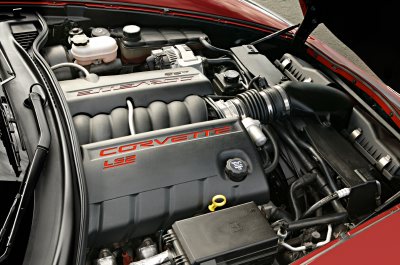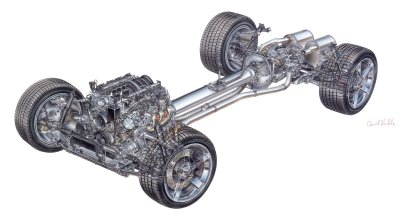|
For
Release: Jan. 1, 2004, 12:01 a.m.
2005 CORVETTE ENGINE: MOST STANDARD
POWER EVER
DETROIT - GM today announced the new 2005
Corvette will feature the most powerful standard engine ever in
Corvette history: the 400 horsepower, 6.0-liter, small-block V-8.
The new 6.0-liter LS2 is part of the fourth generation of GM’s
small-block engines. The small-block debuted in 1955 with 265 cubic
inches and 195 horsepower. Since then, this legendary family of
engines has been an integral component of Corvette’s performance
history.
“It’s almost impossible to talk about Corvette without the
small-block,” said Dave Muscaro, GM Powertrain’s assistant chief
engineer of small-blocks for cars. “As Corvette has grown into a
world-class sports car, the small-block has grown with it. The LS2
is a state-of-the-art engine that draws on a rich heritage of
performance.” Powertrain’s assistant chief
engineer of small-blocks for cars. “As Corvette has grown into a
world-class sports car, the small-block has grown with it. The LS2
is a state-of-the-art engine that draws on a rich heritage of
performance.”
The LS2 also raises the bar for standard performance in the
Corvette, delivering 400 horsepower at 6000 rpm and 400 lb.-ft. of
torque at 4400 rpm – an increase of 50 horses and 40 lb.-ft. of
torque over the previous Corvette’s LS1 engine.
“More than dynamometer numbers, the LS2 engine’s range of power
and torque is broad and very usable in everyday driving,” said
Muscaro. “This engine is smoother, and more refined, but at the same
time retains tire-thrashing output.”
Design changes for the better
Compared to the
Gen III-based LS1, the LS2 incorporates several significant changes
that help improve performance, reliability and serviceability:
-
All-new aluminum block casting incorporates provisions for
external knock sensors and revised oil galleries; external sensors
improve serviceability
-
Cylinder bore diameter increased to 101.6 mm (4.00 inches),
increasing displacement to 6.0 liters
-
Camshaft lift increased to take advantage of increased
cylinder head flow
-
Camshaft sensor relocated from the rear of the block to the
front of the block provides room for new oil galleries
-
Flat-top piston design with lower ring tension reduces
friction
-
Piston floating wrist pins help quiet the engine
-
Redesigned, “wingless” oil pan with cast baffling has reduced
mass and provides superior oil control under high-performance
driving maneuvers
-
Revised exhaust manifolds are 33 percent lighter
-
More efficient ignition coils require less energy to provide a
comparable spark
-
Compression raised to 10.9:1
-
Larger, 90-mm single-blade throttle body
-
Reduced-mass water pump design with improved sealing
capability
-
Engine “redline” raised to 6500 rpm
-
Revised and more powerful engine controller incorporates all
electronic throttle control functions.
-
Mass has been reduced by 7 kilograms on the automatic version.
Cylinder heads for the LS2 are derived from designs used in
previous Corvette Z06 models, including raised intake ports and an
unshrouded-valve combustion chamber design that, when combined with
the engine’s flat-top pistons, produces a more efficient swirl of
the air/fuel mixture. This efficiency enables a higher 10.9:1
compression ratio, which increases fuel economy and horsepower.
Valves measure 2 inches for the intake and 1.55 inches for the
exhaust. The valve springs also have been upgraded to withstand the
engine’s increased power and rpm range.
The LS2’s new oil pan was developed to ensure oil delivery
commensurate with Corvette’s high-performance capability. Extensive
track testing has shown the new design to provide better oil control
under the extreme demands of high-rpm/high g-force driving
maneuvers. The elimination of the previous “gull wing” oil pan
design also reduces the engine’s oil capacity from 6.5 quarts to 5.5
quarts with a dry filter.
Engineers also increased the efficiency and reduced the mass of
the exhaust manifolds. Wall thickness of the manifolds is reduced
from 4 mm to 3 mm, eliminating weight and helping enhance airflow by
approximately 4 percent.
“We sweated the details to ensure the engine maintains a balance
between performance and efficiency,” Muscaro said.
Several of the new features of the LS2 were incorporated as
continuous improvements to later versions of the Gen III engine,
including long-life, iridium-tip spark plugs; pistons with full
floating wrist pins; a redesigned water pump that significantly
reduces the probability of a leak; and a stronger, long-life timing
chain.
Building on a proven foundation
The LS2’s Gen
IV architectural roots lie in the proven LS1 5.7-liter Gen III V-8
that was standard in the Corvette C5. It was an engine that
redefined performance and efficiency expectations of cam-in-block
architecture.
Like the venerable small-block engine introduced in 1955, the
modern small-block features a 90-degree cylinder bank arrangement
and 4.40-inch bore centers – the distance between the center of one
cylinder and the center of the next. The Gen IV builds upon the
strengths of the Gen III small-block architecture, including:
Aluminum block with iron cylinder bore liners: The lightweight
block is cast from 319-T5 aluminum with cast-in-place iron cylinder
bore liners. A die-cast aluminum valley cover and upper deck rails
tie together the cylinder banks, increasing torsional and bending
stiffness.
Deep skirt block: Structural rigidity and operating smoothness is
enhanced because the engine block extends below the crankshaft
centerline.
Cross-bolted main caps: Two horizontal cross bolts for each main
bearing cap complement four traditional vertical main cap bolts and
contribute additional strength and smoothness to the engine’s
rotating assembly.
Gerotor oil pump: Simple and compact in design, the gerotor-style
oil pump fits the shallow oil pan and offers superior pumping
capability.
Balanced cylinder head design: Performance and efficiency is
enhanced with identical airflow and energy direction for each
cylinder.
Coil-near-plug ignition: A separate ignition coil pack and short
spark plug wire for each cylinder maximize the efficiency of the
delivered coil energy, enhancing fuel efficiency and power.
Electronic throttle control (ETC): Instead of a mechanical
linkage between the gas pedal and engine throttle, an electronic
throttle control system improves driveability and reduces overall
system complexity by eliminating typical conventional mechanical
items, such as the idle air control motor, cruise control module and
throttle relaxer (traction control).
Because the LS2’s new engine controller incorporates ETC
commands, the separate ETC module used on the LS1 is no longer
required. This allows faster communication of the controller to the
throttle, as well as reducing the mass and complexity of the system.
Additionally, emissions are slightly improved with the damping of
unnecessary throttle movement.
Improvements to the engine’s crankcase breathing and ventilation
were made similar to the LS6 engine, including moving the crankcase
ventilation system’s PCV valve away from the rocker covers and into
the block valley.
“The small-block V-8 is a powerful and continually refined
package that stacks up with the best engines around the globe,” said
Muscaro. “The Corvette is simply the best way to showcase its
world-class traits.”
 Exhaustive efforts Exhaustive efforts
Advances in catalyst
substrates made possible catalytic converters that are at the same
time more effective and less restrictive for the LS2’s exhaust. The
new converters are mounted closer to the exhaust manifold for
quicker lightoff and reduced cold-start emissions. As a result, the
more restrictive quad catalyst design of the LS1 – with its small,
auxiliary “pup” converters – was not necessary to meet emissions
requirements. An additional benefit of the exhaust system’s
development was the elimination of the LS1’s air injection reaction
system.
Subtle adjustments were made to the Corvette exhaust system
itself to improve its performance. Sharp angles in the tubing have
been replaced with more gradual bends. A larger muffler volume and
tri-flow technology eliminated certain periods prone to unwanted
noise, particularly between 1500 and 2400 rpm. An inline muffler
that flows more efficiently replaces the laterally mounted muffler
in the C5. These changes, coupled with one converter per exhaust
bank, reduced backpressure in the system and contributed to the
LS6’s 400 horsepower and 400 lb.-ft. of torque.
Changing gears
The 2005 Corvette continues to
offer drivers thrilling driving dynamics, whether they prefer
shifting or leaving it to the transmission. The Tremec T56 six-speed
manual is standard and the Hydra-Matic 4L65-E four-speed automatic
is optional.
Corvette engineers thoroughly revised the Tremec gear box and
added proprietary technology not offered on other automakers’
high-performance transmissions. The six-speed transmission also has
revised gearing when selected with the Z51 performance option. With
the Z51, the Tremec is tailored with numerically higher gears to
improve acceleration. Also, a lower fifth gear gives the Z51 better
fuel efficiency and a higher top speed than base models. To increase
durability in sustained high-speed situations, the Z51 and the base
European manual-transmission models have a transmission cooler.
Smoother shifting six-speed
2005 Corvette
drivers will find more pleasing, performance-oriented shifts with
the six-speed transmission. They’re smoother and more precise, with
shorter overall throws. The gear shift lever is now an inch shorter,
and travel for all synchronizers is reduced by 10 percent. An
all-new shift linkage and shift-rail bearings contribute to a more
positive, confident feel. Computer Aided Gear Selection (CAGS)
continues as a fuel-economy enhancement function for the manual
transmission.
Durable 4L65-E delivers automatic
performance
The available automatic transmission in the
Corvette is the new Hydra-Matic 4L65-E four-speed. An upgraded
version of the C5’s 4L60-E, the “L65” is strengthened and revised to
accommodate the LS2’s 400 lb.-ft. of torque.
To beef up the internals, a five-pinion planetary gear set was
added – replacing a four-pinion gear set. The extra gear reduces
friction and loads carried by all the gears. The washers between the
gear sets are made from Teflon, allowing optimal operation at high
speed.
For protection from the high temperatures that are generated by
high speed, a four-plate oil cooler has been added. When the
transmission fluid reaches 127 degrees Celsius (approximately 260
F), the torque converter lock does not disengage, except briefly
during shifts. This prevents fluid shear in the torque converter
from adding heat to the transmission.
The 4L65-E uses a highly advanced electronic controller that has
been specifically calibrated for Performance Algorithm Shifting.
This technology automatically selects the optimal gear for a given
driving condition, making it a willing accomplice for performance
driving and hard cornering. The 4L65-E transmission shifts at higher
rpm, compared to the C5’s 4L60-E, to take advantage of the LS2’s
higher horsepower and rev range.
|
